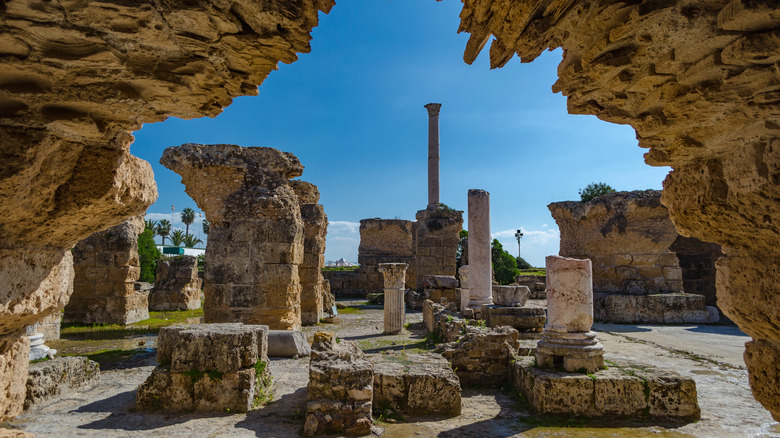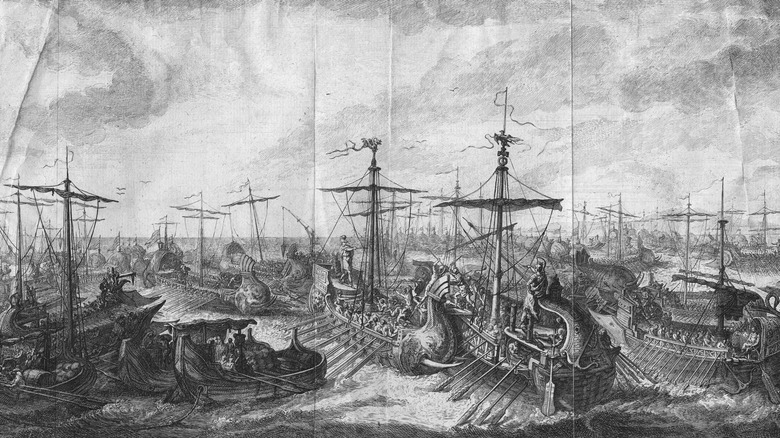The Truth About The Roman Empire's Siege On Carthage
On the northern coast of Africa, where the city of Tunis, capital of Tunisia is currently situated, once lay the ancient city of Carthage (via Britannica). One of the largest and most powerful city-states from the days of antiquity, Carthage was founded in 814 B.C. by Elissa, also known as Queen Dido (via Britannica), according to the legends. From 814 B.C. to 146 B.C., Carthage ruled the Mediterranean. With it's 220 docks, situated between two harbors — one for trade, the other for warships — Carthage was a powerful force in the region (via World History).
However, power breeds jealousy. Circa 264 B.C., the city-island of Sicily was mutually controlled by Carthage and the then fledgling Roman Empire. Two opposing forces, Rome was jealous of the empire Carthage had created and continued to add cities and countries, too. According to Britannica, a dispute between the cities of Corsica and Sicily caused Carthage to leave a military presence on the island.
The First Punic War
Rome saw this action as a threat and attacked the Carthaginian presence on the island, thus starting the First Carthaginian War, better known as the First Punic War. For nearly the next 25 years, both countries fought over the island, wrestling control for years at a time from the other. That is, until 241 B.C., when Rome gave a final push. According to Britannica, Rome sent a fleet of over 200 warships to block the sea lanes merchants used to bring goods into Sicily. After a year of the blockade, Carthage surrendered the city — and island — to Rome.
Peace would not last in the region, however. With the victory at Sicily, Rome continued to grow in strength and boldness. After a quarter century of tenuous peace, tensions between the two powerhouses began ramping up circa 218 B.C. According to Daily History, a Carthaginian general named Hannibal Barca single-handedly began the Second Punic War. After surrendering Sicily, and much of the empire to Rome at the conclusion of the First Punic War, Carthage had a huge chip on its collective shoulders. Since Carthage agreed not to interfere with Italian affairs with the signing of the treaty, Hannibal made a secret alliance with a contingency of Celtic people living in Northern Italy that had defeated Rome years prior and now called the region home.
The Second Punic War
Hannibal's plan was to lead the Carthaginian-Celtic forces and attack Rome through Spain, which was part of the Roman Empire at the time. Hannibal led his forces into the Roman ally city of Saguntum. A huge metropolis, Saguntum was a key trade center in Spain and for Rome in that region. In eight months time, Hannibal sacked the city, killing all the adults and enslaving the children, per Daily History. Using Saguntum as a base of operations, Hannibal was able to recruit an army of over 90,000 soldiers, as well as at least 35 war elephants (via The New York Times).
With his new army, Hannibal crossed the Alps, by way of Spain, into Italy and quickly won over several Italian towns. However, the tides would turn against Hannibal in 203 B.C., when he would have to leave his post in Italy to defend Carthage in North Africa. Meanwhile, Rome pushed back against the Carthaginians that had been holding Spain, recapturing it and effectively ending the Second Punic War. Carthage's empire would shrink considerably to just the northern coast of Africa, give up its entire fleet and pay damages to Rome in the form of silver (via History).
The Third Punic War
Over the next 50 years, both countries coexisted. Carthage, in its weakened state, was no real threat to Rome any longer. Because of its geographical location, however, Carthage was still an economic powerhouse. The Romans saw this, especially the country's merchant class (via Britannica), and wanted it. Circa 149 B.C., Carthage declared war on the country of Numida. A Roman ally, Carthage effectively broke the treaty signed at the conclusion of the Second Punic War. Using this as the excuse they were waiting for, Rome sent an army to attack Carthage.
Over the next two years, Rome bombarded Carthage. By 146 B.C., Carthage and its 700-year-old history had been wiped off the Earth (via History). The 50,000 Carthaginians that survived the massacre were sold off into slavery. With the defeat of Carthage, Rome continued across the continent of Africa, absorbing countries along the way. By the end of 146 B.C., the Roman Empire ruled from the coast of Spain, across Europe to Greece, and as far as modern-day Turkey.



